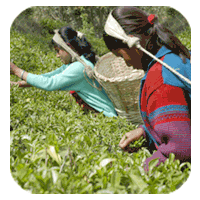Nepal Tea
Introduction
 With the advantage of diverse agro-climatic conditions and eco-friendly cultivation methods having very little or no inorganic fertilizers and pesticides in use, Nepal is producing very good quality tea. both CTC and orthodox tea.
With the advantage of diverse agro-climatic conditions and eco-friendly cultivation methods having very little or no inorganic fertilizers and pesticides in use, Nepal is producing very good quality tea. both CTC and orthodox tea. Beginning of tea plantation in Nepal goes back to the year 1861 when Mr. Gajaraj Singh Thapa., the Chief Administrator of Ilam district and the close relative of the Rana Prime Minister Jung Bahadur Rana planted the first tea garden-the present day Ilam Tea estate, with an approximately 5o hectares.
Today, Nepal has in total an estimated 10,000 ha. of its land under tea plantation. Hill plantation is estimated at 3,400 ha. consisting of more than 40 tea gardens, around 4,500 out growers and 11 tea grown in terai is used for making CTC (black tea) and hill tea is exclusively processed for making the orthodox tea. is exported to the overseas and dust grades are used by tea blenders and packers. Almost all CTC produced within the country is marketed locally for domestic consumption. The production of CTC and orthodox tea in Nepal is around 5.4 and 0.6 million kg. respectively. Nepalese orthodox tea, which is produced at altitude between 3, 000 ft. to 7, 000 ft. are famous for their aroma, bright liquor and subtle, slight fruity flavour.
Tea in Nepal has good prospects due to: agro-ccological conditions; expanding markets; environmental considerations; employment and rural development.
The major hill plantation districts are : Ilam, Terathum, Dhankuta, and Panchthar and it is expanding to other hilly districts too. Terai tea plantation is Jhapa district.
Export Market
The demand for orthodox tea in the world market is increasing due to the increase in the health conscious customers. Presently, the major markets for thigh value orthodox tea are EU, Japan and the US. where consumers are highly sensitive regarding the quality and the background of the product, which they use. Specialty teas, like tea from specific garden of specific grade and specific flush or organic tea or teas with minimum or no pesticide residue, are in demand in these countries as niche products in niche markets property for commercial cause.
Nepalese Orthodox teas are exported to overseas countries; India and Significant amount is sent in gift packs.
Nepalese Orthodox teas are exported to overseas countries; India and Significant amount is sent in gift packs.
Major Tea Manufacturers of Nepal
CTC Tea
1. Aroma Tea Estate (P) Ltd. Jhapa
2. Bajgain Tea Farming & Processing (P) Ltd., Jhapa
3. Bansal Tea Estate (P) Ltd., Jhapa
4. Budhakaran & Sons Co. (P) Ltd., Jhapa
5. Buttabari Tea Processing (P) Ltd., Jhapa
6. Danfe Tea Processing Company (P) Ltd., Jhapa
7. Giribandhu Tea Estate (P) Ltd., Jhapa
8. Haldibari Tea Industies (P) Ltd., Jhapa
9. Himalayan Goodrick (p0 Ltd., Morang
10. Kalika Tea Estate (p0 Ltd., Jhapa
11. Loknath & Sons Tea Estate (P0 Ltd., Jhapa
12. Mittal Tea Estate (P) Ltd., Jhapa
13. Nakalbanda Tea Estate (p0 Ltd., Jhapa
14. New Giri & Sons Tea Estate (P) Ltd., Jhapa
15. Raj Tea Estate (P) Ltd., Jhapa
16. Sattighatta Tea Estate (P) Ltd., Jhapa
17. Soktim Tea Estate (NTDC-Triveni Group P. Ltd.), Ilam
18. Tokla Tea Estate (NTDC-Triveni Group P. Ltd.), Jhapa
Orthodox Tea
1. Guranse Tea Estate-Dhankuta
2. Himalaya Sangrila Tea Producers (P) Ltd., Ilam
3. Himalayan Range Tea Industry-Ilam
4. Ilam Tea Estate-Ilam
5. Ilam Tea Producers-Panchakanya Branch-Ilam
6. Ilam Tea Producers (P) Ltd.-Ilam
7. Kanchanjungha Tea Estate-Phidim
8. Kanyam Tea Estate- Ilam
9. Nepal Small Tea Producers (P) Ltd. Ilam
10. Sakhejung Hill Range Tea Industries-Ilam
11. Sri Antu TEa Industries-Ilam
Salient Features of National Tea policy 2000
National Tea Policy 2000 announced for planned development/promotion of tea sector. The policy aims at:
• Target coverage of plantation area by 40,875 ha. within 5 years
• Annual target production of tea by ten year: 46.11 million kg. (65% of orthodox tea)
• Additional employment opportunity for 79, 310 persons.
• Annual target production of tea by ten year: 46.11 million kg. (65% of orthodox tea)
• Additional employment opportunity for 79, 310 persons.
The Policy spells out Some major incentive packages, commitments for the existing and potential stakeholder in the commercial tea development and restructuring the composition and functioning of the Tea Board with more participation of the private sector stakeholders.
• Priority lending, principle repayment and interest payment schedule facilitation,
• Rebate on the land registration tax,
• Up to 50 year's lease prospect Government land,
• Creation of tea development fund,
• Introduction of cess (service fee) to manufacturers and traders (importers/exporters),
• Establishment of Research and Training centres in collaboration with private sector,
• Incentives to ancillary industries
• New Institutional Arrangements of Board with more Pvt. secotr participate
• Provision of Tea Development Fund.
• Rebate on the land registration tax,
• Up to 50 year's lease prospect Government land,
• Creation of tea development fund,
• Introduction of cess (service fee) to manufacturers and traders (importers/exporters),
• Establishment of Research and Training centres in collaboration with private sector,
• Incentives to ancillary industries
• New Institutional Arrangements of Board with more Pvt. secotr participate
• Provision of Tea Development Fund.
OUR TEA






